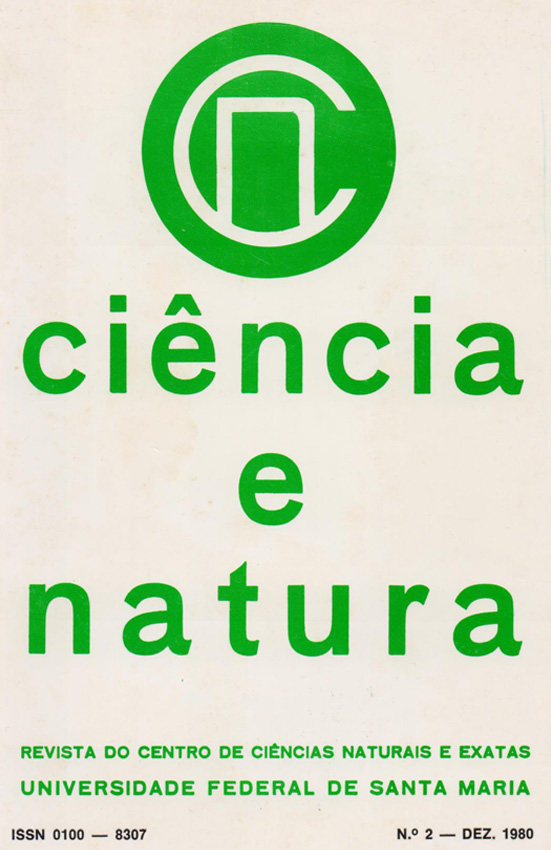Textural analysis of Tupanciretã formation
DOI:
https://doi.org/10.5902/2179460X24864Abstract
The Tupanciretã Formation in Rio Grande do Sul, is made up by basal conglomerate, that occurs only at the southern part of the area, by sandstone, siltstone and clay. The main lithologyconsists on fine to very fine sandstones, frequantly silty-sandstones. They presents the mean size from about2 to 4 ∅, standard deviation ranging between 1,0 to 2,0, sometimes 2,0 to 4,0, being from poorly to bad classificated. The skewness is positive and the distribution is lepto to mesokurtic.
The sand grains presents high sphericity, ranging 0,8 and 0,9, sub-rounded borders, about 0,6, kindney-from polished surface texture.
Downloads
References
BIGARELLA, J.J.; HARTKOPF, C.C.; SOBANSKI, A. & TREVISAN, N. Textura Superficial dos grãos em areias e arenitos (contribuição à metodologia). Arquivos de Biologia e Tecnologia, Curitiba, 10 (11) :253-75, 1955.
BIGARELLA, J.J. & SALAMUNI, R. Caracteres texturais dos sedimentos da Bacia de Curitiba. Boletim da Universidade do Paraná- Geologia, Curitiba, 7, 1962.
FOLK, R.L. Stages of textural maturity in sedimentary rocks. Journal of Sedimentary Petrology, Tulsa, 21(3): 1927-30, 1951.
FOLK, R.L. & WARD, W.C. Brazos River Bar: a study on the signification of grain size parameters. Journal of Sedimentary Petrology, Tulsa, 27 (1): 3-26, 1957.
FREITAS, R.C. Sedimentologia e Paleogeografia dos depósitos piemônticos na usina dos Peixotos. Revista Brasileira de Geografia, Rio de Janeiro, 18 (3): 323-72, 1957.
GAMERMANN, N.; CARRARO, C.C.; EICK, N.C. & BORTOLUZZI, C.A. Geotransversal brasileira norte-sul (parcial). Projeto Internacional do Manto Superior. Rio Grande do Sul. Pesquisas, Porto Alegre, 2 (1): 49-60, 1973.
INMAN, D.L Sorting of sediments in the light of fluid mechanics. Journal of Sedimentary Petrology, Tulsa, 19 (2): 55-70, 1949.
KRUMBEIN, W.C. The mechanical analysis of fine grained sediments. Journal of Sedimentary Petrology, Tulsa, 2 (3): 140-50,1932.
KRUMBEIN, W.C. Measurement and geological significance of shape and roundness of sedimentary particles. Journal of Sedimentary Petrology, Tulsa, 11 (2): 64-72, 1941.
KRUMBEIN, W.C. & PETTIJOHN, F.J. Manual of Sedimentary Petrography. New York, Apleton Century Crofts Inc., 1938, 549 p.
MARTINS, L.R. Significance of Skewness and Kurtosis in environmental interpretation. Journal of Sedimentary Petrology, Tulsa, 35 (3): 768-70, 1965.
MARTINS, L.R. Aspectos texturais e deposicionais dos sedimentos praiais e eólicos da Planicie Costeira do Rio Grande do Sul. Publicação especial da Escola de Geologia da UFRGS, Porto Alegre, 13: 1-102, 1967.
MENEGOTTO, E. Sedimentologia da Formação Tupanciretã, Porto Alegre, Curso de Pôs-Graduação em Geociências, UFRGS, 1971,59p. (dissertaçãode mestrado).
MENEGOTTO, E., SARTORI, P.L. & MACIEL FILHO,C.L., Nova sequencia sedimentar sobre a Serra Geral no Rio Grande do sul, Santa Maria, Secção de Geologia, ISC, UFSM, 1968, 19 p. (publ. esp .nº 1).
MORRIS, W.J. Effects of sphericity, roundness and velocity on traction transportation of sand grains. Jour. of Sediment Petrol., Tulsa, 27 (1): 27-31, 1957.
PETTIJOHN, F.J. Sedimentary Rocks. New York, Harper and Brothers, 1956, 718 p.
RITTENHOUSE, G. A visual method of estimating two-dimensional sphericity. Jour. of Sed. Petrol., Tulsa, 13: 79-81,1943.
TWENHOFEL, W.H. The rounding of sand grains. Jour. Of Sed.Petrol., Tulsa, 15 (2): 59-71, 1945.
WENTWORTH, C.K. Fundamental limits to the size of clasticgrains. Science, Lancaster, 77: 633-634, 1933.
Downloads
Published
How to Cite
Issue
Section
License
To access the DECLARATION AND TRANSFER OF COPYRIGHT AUTHOR’S DECLARATION AND COPYRIGHT LICENSE click here.
Ethical Guidelines for Journal Publication
The Ciência e Natura journal is committed to ensuring ethics in publication and quality of articles.
Conformance to standards of ethical behavior is therefore expected of all parties involved: Authors, Editors, Reviewers, and the Publisher.
In particular,
Authors: Authors should present an objective discussion of the significance of research work as well as sufficient detail and references to permit others to replicate the experiments. Fraudulent or knowingly inaccurate statements constitute unethical behavior and are unacceptable. Review Articles should also be objective, comprehensive, and accurate accounts of the state of the art. The Authors should ensure that their work is entirely original works, and if the work and/or words of others have been used, this has been appropriately acknowledged. Plagiarism in all its forms constitutes unethical publishing behavior and is unacceptable. Submitting the same manuscript to more than one journal concurrently constitutes unethical publishing behavior and is unacceptable. Authors should not submit articles describing essentially the same research to more than one journal. The corresponding Author should ensure that there is a full consensus of all Co-authors in approving the final version of the paper and its submission for publication.
Editors: Editors should evaluate manuscripts exclusively on the basis of their academic merit. An Editor must not use unpublished information in the editor's own research without the express written consent of the Author. Editors should take reasonable responsive measures when ethical complaints have been presented concerning a submitted manuscript or published paper.
Reviewers: Any manuscripts received for review must be treated as confidential documents. Privileged information or ideas obtained through peer review must be kept confidential and not used for personal advantage. Reviewers should be conducted objectively, and observations should be formulated clearly with supporting arguments, so that Authors can use them for improving the paper. Any selected Reviewer who feels unqualified to review the research reported in a manuscript or knows that its prompt review will be impossible should notify the Editor and excuse himself from the review process. Reviewers should not consider manuscripts in which they have conflicts of interest resulting from competitive, collaborative, or other relationships or connections with any of the authors, companies, or institutions connected to the papers.







